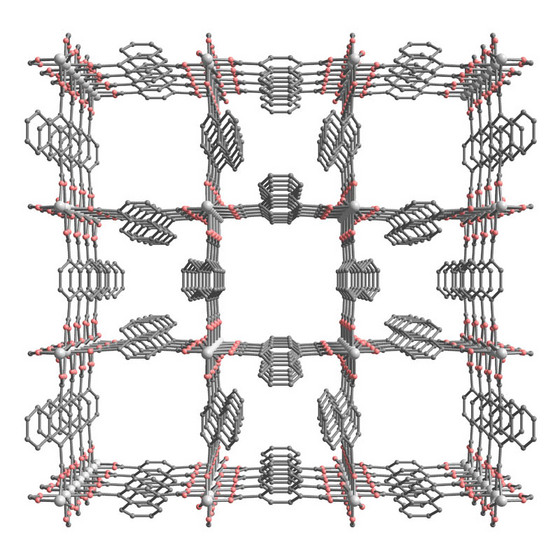Home > Press > Porous material sized up
 |
| Figure 1: A schematic of the metal-organic framework, which contains a highly ordered network of small and large nanopores. |
Abstract:
A metal-organic framework that contains ordered channels of two different sizes can separate different gases
Porous material sized up
Japan | Posted on February 26th, 2009The material's structure is based on a three-dimensional lattice of aluminum atoms, surrounded by oxygen atoms. These clusters are connected by a carbon-based molecule called 1, 4-naphthalene dicarboxylate (1, 4-NDC). Such metal-organic frameworks (MOFs) are finding uses in separating liquids or gases, acting as catalysts to speed up chemical reactions, or for safely storing large volumes of gas.
The international team of scientists that made the material, including Masaki Takata of RIKEN's Harima Institute, used x-rays to reveal that it contains ordered channels of two different sizes1. The smaller channels, crowded by napthalene units, are just 0.3 nanometers (billionths of a meter) across, while the larger channels are 0.77 nanometers across (Fig. 1).
"We expected the porous structure to some extent," says Satoshi Horike, now at the University of California, Berkeley, who was part of the team. "But the existence of two kinds of pores in our system is kind of surprising."
The team then used nuclear magnetic resonance (NMR), a technique which measures the magnetic behavior of atomic nuclei, to build up a more detailed three-dimensional picture of the MOF.
The scientists analyzed a sample of the inert gas xenon as it diffused through the MOF's pores. This experiment confirmed that the material has parallel, yet independent, pores. Xenon atoms have a diameter of about 0.44 nanometers, and did not fit down the smaller channels. However, it took mere milliseconds for the xenon to diffuse through the larger channels, which were not blocked by any other molecules, such as water.
Carbon dioxide could also seep through the material. The scientists calculate that each gram of the MOF can bind carbon dioxide to an internal surface area which is greater than 500 m2, roughly the size of two tennis courts.
And while the small organic molecules methanol and acetone were easily absorbed, more pressure was required to squeeze water into the pores because of high hydrophobicity. This could make the material useful for separating water from alcohols, suggests Horike. "Gas separation between water and ethanol is important for obtaining liquid fuel from biomass sources," he says.
The smaller pores could also be useful for storing hydrogen gas, a potentially environmentally friendly fuel. "Hydrogen has a really small interaction with pore surfaces," explains Horike, "and the small pore would be able to bind hydrogen gas more tightly than the large one."
Reference
1. Comotti, A., Bracco, S., Sozzani, P., Horike, S., Matsuda, R., Chen, J., Takata, M., Kubota, Y. & Kitagawa, S. Nanochannels of two distinct cross-sections in a porous Al-based coordination polymer. Journal of the American Chemical Society 130, 13664-13672 (2008).
The corresponding author for this highlight is based at the RIKEN Structural Materials Science Laboratory
####
For more information, please click here
Copyright © Riken
If you have a comment, please Contact us.Issuers of news releases, not 7th Wave, Inc. or Nanotechnology Now, are solely responsible for the accuracy of the content.
| Related Links |
| Related News Press |
News and information
![]() Researchers develop molecular qubits that communicate at telecom frequencies October 3rd, 2025
Researchers develop molecular qubits that communicate at telecom frequencies October 3rd, 2025
![]() Next-generation quantum communication October 3rd, 2025
Next-generation quantum communication October 3rd, 2025
![]() "Nanoreactor" cage uses visible light for catalytic and ultra-selective cross-cycloadditions October 3rd, 2025
"Nanoreactor" cage uses visible light for catalytic and ultra-selective cross-cycloadditions October 3rd, 2025
![]() Researchers tackle the memory bottleneck stalling quantum computing October 3rd, 2025
Researchers tackle the memory bottleneck stalling quantum computing October 3rd, 2025
Chemistry
![]() "Nanoreactor" cage uses visible light for catalytic and ultra-selective cross-cycloadditions October 3rd, 2025
"Nanoreactor" cage uses visible light for catalytic and ultra-selective cross-cycloadditions October 3rd, 2025
![]() Cambridge chemists discover simple way to build bigger molecules – one carbon at a time June 6th, 2025
Cambridge chemists discover simple way to build bigger molecules – one carbon at a time June 6th, 2025
Discoveries
![]() Researchers develop molecular qubits that communicate at telecom frequencies October 3rd, 2025
Researchers develop molecular qubits that communicate at telecom frequencies October 3rd, 2025
![]() Next-generation quantum communication October 3rd, 2025
Next-generation quantum communication October 3rd, 2025
![]() "Nanoreactor" cage uses visible light for catalytic and ultra-selective cross-cycloadditions October 3rd, 2025
"Nanoreactor" cage uses visible light for catalytic and ultra-selective cross-cycloadditions October 3rd, 2025
Announcements
![]() Rice membrane extracts lithium from brines with greater speed, less waste October 3rd, 2025
Rice membrane extracts lithium from brines with greater speed, less waste October 3rd, 2025
![]() Researchers develop molecular qubits that communicate at telecom frequencies October 3rd, 2025
Researchers develop molecular qubits that communicate at telecom frequencies October 3rd, 2025
![]() Next-generation quantum communication October 3rd, 2025
Next-generation quantum communication October 3rd, 2025
![]() "Nanoreactor" cage uses visible light for catalytic and ultra-selective cross-cycloadditions October 3rd, 2025
"Nanoreactor" cage uses visible light for catalytic and ultra-selective cross-cycloadditions October 3rd, 2025
|
|
||
|
|
||
| The latest news from around the world, FREE | ||
|
|
||
|
|
||
| Premium Products | ||
|
|
||
|
Only the news you want to read!
Learn More |
||
|
|
||
|
Full-service, expert consulting
Learn More |
||
|
|
||








